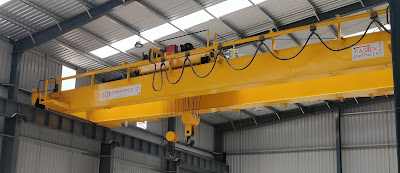Learn Everything About Overhead Cranes
Construction industry has
undergone phenomenal metamorphosis. Living spaces, corporate and commercial buildings,
and recreational places are vigorously shaking the salt-shaker of creativity
and imagination.
If real estate builders and
developers are experimenting with eco-friendly spaces, construction equipage
providers are working their fingers to the bones to afford the best implements.
This is undoubtedly true. Both these industries work hand in glove to construct
some of the most marvelous buildings and spaces.
Have a gander at one of the
best industrial crane manufacturers SGF Fab. Their tools are in a class of their own. Reliability, durability,
rust-resistance, weather-resistance, and the ability to stand the test of time
are some of the peerless characteristics of these pre-cast handling crane manufacturers' (in Bangalore) implements.
These crane manufacturers and suppliers'
semi-gantry cranes, jib cranes, H.O.T. cranes, single girder/double girder
EOT, and a host of other devices are foolproof.
If you are looking for a
trustworthy company that can supply major construction tools, look no more. SGF
Fab industries also deal in wonderful material handling equipment (MHE).
Cranes and hoist equipment are
the cornerstone of any construction project. Reliable implements can make the
job of workers and engineers easy. Some of the equipment can even perform
multifarious tasks.
Therefore, it is utterly
important to know chapter and verse on cranes and other vital, time-honored
clobber.
Classification
Class A – Infrequent or Standby
These cranes are bodacious for precise handling at slow speeds. They are
a fabulous choice for powerhouses, public utilities, turbine rooms, motor
rooms, and transformer stations.
Class B – Light Service
This class is completely suitable for environments with
light service requirements and low speed needs. They can handle two to five
lifts per hour, and work well for repair shops, light assembly operations,
service buildings, and light warehousing.
Class C – Moderate Service
Environments with moderate service requirements use these
cranes , like machine shops, paper mill machine rooms, and other such. They can
handle loads that average 50% of the rated capacity, making five to ten lifts
per hour, with not over 50% of the lifts at rated capacity.
Class D – Heavy Service
These cranes may be used in heavy machine shops,
foundries, fabricating plants, steel warehouses, container yards, lumber mills,
etc., and standard duty bucket and magnet operations where heavy-dutyproduction is required.
Class E – Severe Service
These cranes are capable of handling loads approaching a
rated capacity throughout its life. Applications may include magnet, bucket,
magnet/bucket combination cranes for scrap yards, cement mills, lumber mills,
fertilizer plants, container handling, etc., with twenty of more lifts per hour
at or near the rated capacity.
These cranes are capable of handling loads approaching
rated capacity continuously under severe service conditions throughout its
life. Applications may include custom designed specialty cranes essential to
performing the critical work tasks affecting the total production facility.
These cranes must provide the highest reliability with special attention to
ease of maintenance features.
Crane Selection Criteria
Now that you know crane taxonomy, you might want to get
genned up on the selection criteria. Select the right crane to prevent
hamstrings and damage. Have a gander -
Speed – Measured in lifts per hour, this is how quickly the
crane is able to move materials and equipment.
Service – The crane’s frequency of use.
Distance – The distance a crane needs to move the lifted materials.
Rated Capacity – The average rated load of materials
moved determines rated capacity.
Maintenance Requirements – How often the crane needs to be
serviced.
Service Conditions – The environment in which a crane
will operate, and its access for servicing, are important factors.
(Inputs from American Crane)

Comments
Post a Comment